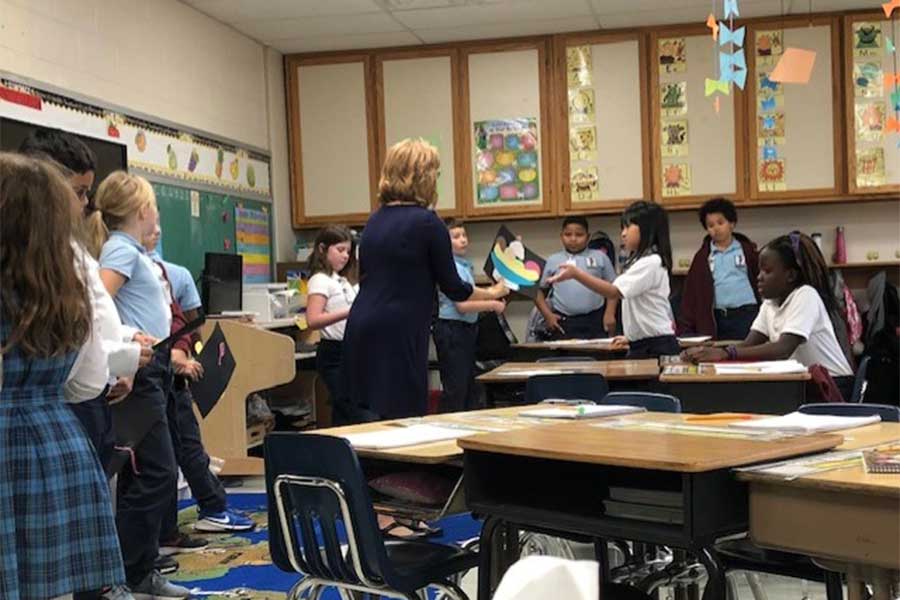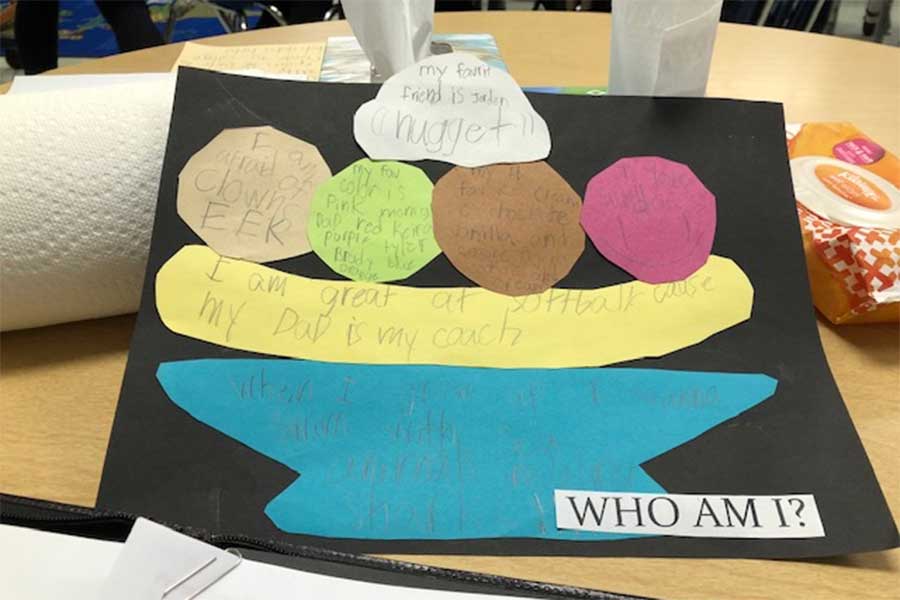Elementary River Stories
Developed by Karen Wilson
St. Peter School
Language Arts
Grade Level: 3rd
Introduction
Most teachers struggle to build empathy and community into already tight schedules and required subject area content. However, most social scientists tell us that these skills are needed in society more than ever before. During the Muse Machine 2019 Summer Institute creative methods for helping teachers incorporate these subjects were discussed and modeled for educators. Starting with the topics of self and identity, Ping Chong + Company demonstrated methods for teaching students to have a greater sense of self-esteem and understanding of others throughout the 4-day workshop. Karen Wilson, from St. Peter School, demonstrates how she used these methods with very young children. The results are useful and heartwarming!
Click here to view/download this lesson plan as a PDFInspiration
During the Muse Machine Summer Institute 2019, we learned about identity and sense of self from Ping Chong + Company. I used this theme for the lesson: How are stories from other places and times about me?


Overview
Summary
Students learn to build empathy and a community of love through sharing personal stories. Building on our community, we create a safe space to share our stories and help one another heal.
Standards
Archdiocesan Reading/English Language Arts Graded Course of Study (GCS)
W.3.5 With guidance and support from peers and adults, develop and strengthen writing as needed by planning, revising, and editing.
W.3.10 Recall routinely over extended time frames (time for research, reflection, and revision) and shortened time frames (a single sitting or a day or two) for a range of discipline-specific tasks, purposes, and audiences.
SL.3.1 Engage effectively in a range of collaborative discussions (one-on-one, in groups, and teacher-led) with diverse partners on grade 3 topics and texts, building on others’ ideas and expressing their own clearly.
SL.3.3 Ask and answer questions about information from a speaker, offering appropriate elaboration and detail.
SL.3.6 Speak in complete sentences when appropriate to task and situation in order to provide requested detail or clarification.
L.3.1 Demonstrate command of the conventions of standard English grammar and usage when writing or speaking.
L.3.2 Demonstrate command of the conventions of standard English capitalization, punctuation, and spelling when writing.
L.3.3 Use knowledge of language and its conventions when writing, speaking, reading, or listening.
L.3.5 Demonstrate understanding of figurative language, word relationships and nuances in word meanings.
L.3.6 Acquire and use accurately grade-appropriate conversational, general academic, and domain specific words and phrases, including those that signal spatial and temporal relationships.
Objectives/Outcomes
To build a community in the classroom to nurture learning and develop empathy for others
Teaching Approach
class discussion, lecture, written reflection
Assessment
written story and rubric, presentation
Lesson Preparation
Teacher Needs
- chart paper
- markers
- student journals
Teacher Information
Teacher needs to be committed to letting students make some mistakes along the way in this kind of lesson! It also helps if the teacher is willing to share something from his/her own background.
Helpful Hints
Having all materials ready at the beginning is critical to the successful flow of the lesson.
Student Needs
- student journals
- pencils
- Ice Cream Poem
- river story template
Prior Knowledge
Since the beginning of the year, the students have participated in circle games as ice breakers and community building activities. Students have also already developed an Ice Cream Poem, which is a poem to share information about themselves. (I like, I love, I am good at, I am afraid of….)
Student Voice
Students can decide how much of their story they want to share verbally or in written presentation.
Vocabulary
empathy, character, community
Evidence/Assessment of Outcomes
Students made Ice Cream Poems and shared one piece of their poem during the warm-up circle activity. Students’ completed river stories will be displayed on a bulletin board.
I will use a rubric to grade content of writing:
- Did student use sentences to describe their feelings for life events?
- Did student explain what made their feelings change from sadness to joy?
- Did the student share a story with the class?
Enduring Understandings
Everyone belongs to a community. Everyone has their own story to share in a variety of ways. These stories can build bridges to empathy and understanding one another. We can help one another and build a community of love by sharing our stories.
Learning Plan
Prompt
Circle warm-up activity. One at a time, students take turns around the circle sharing their name and one piece of information about themselves from their Ice Cream Poem. Ex. I’m Aubrey and I like to play hopscotch.
After everyone has participated, have students move to their desks and get out journals. Comment on how happy everyone is to be sharing with one another. Let them know that sharing and supporting one another is how communities are built.
Teacher says, “Our Ice Cream Poems share about ourselves and today we are going to share more about ourselves by creating a River Story that shows our lives like a River. Just like a moving river, our lives have ups and downs and turns and twists. Our lives also have specific events that could be represented by stones in a river. For example: Let’s look at our main character this week and look at his life as if it were a river.”
Hooks
(This class studied The Harvest Birds by Blanca Guadalupe López Morales, but other stories can work.)
“In our story this week, Juan has to overcome disappointment from not being left land to farm from his father and ridicule from his neighbors. He listens to his heart and the voice of nature to bring his dreams to fruition. What feelings do you think Juan had? Do you understand how he felt? Have you ever felt that way? Discuss how reading about characters can help us understand our own feelings. Can we relate to feeling disappointed, embarrassed, sad, proud, loved, hopeful, faithful, joyful? This is called empathy when we can feel what a character or another person is feeling.”
Essential Questions
- How are stories from other places and times about me?
Teacher and Student Performance Tasks
- Teacher passes out the River Story template and explains that students will write a river story for the character under discussion.
- Teacher says, “Look at the river and notice the stones starting from the top of the river and going to the bottom. Next to each of those ovals we will write a date to represent a ‘stone’ in the river of someone’s life.”
- Students work with teacher to plot the character’s life events on the river.
Examples:
- Juan’s dad dies and he feels great sadness.
- His brothers get the land, and Juan is disappointed.
- He tries to get someone to buy him land.
- Don lends him land and Juan feels hopeful.
- Etc.
- As a class, discuss how events changed and the character’s feelings changed.
- Teacher says, “Now think back to a time that you might want to write about that stands out in your mind.” Give students some sample topics:
- I remember the first day of school.
- I remember feeling love.
- I remember feeling sad.
- I remember feeling like an outsider.
- I remember feeling loss.
- I remember feeling like I belonged.
- It was the best/worst day of my life.
- Teacher introduces the task, “Next to your own river stone and date, write a sentence that would summarize your story for that date. Then on a blank page in your journal, write details about one of your dates to start a story.”
- Teacher models an example:
1973- In third grade I felt like I belonged. I would like to share that when I was in the third grade I went through a really sad time because my aunt was very sick. I was really worried about her because I knew she was going to die and her kids, who were teenagers, were so sad and scared. One day, I started crying in school and my teacher cared enough to ask me to tell her what was wrong. I finally did, and she comforted me and asked the class to pray together. After that, there were several girls who came up to play with me at recess to cheer me up. I felt like I belonged, and people cared about me. I was so happy that I shared what was bothering me because I didn’t feel like I belonged before.
- Further prompt students to think if there was a time in their life where something started sad and then moved to a joyful feeling. Ask if they can determine what caused the feelings to change and write those events down. Give students 5 minutes to write their story details down in their journals.
- Put them with a partner to discuss their story. Give them 5 minutes to share with partner.
- Finally, direct student pairs to try to come up with a statement of how this situation changed them.
Final Review
Spend 15 minutes giving students the opportunity to share part of their stories in the big circle. Follow up with 20 minutes the following day to write a final copy of their story for display.

